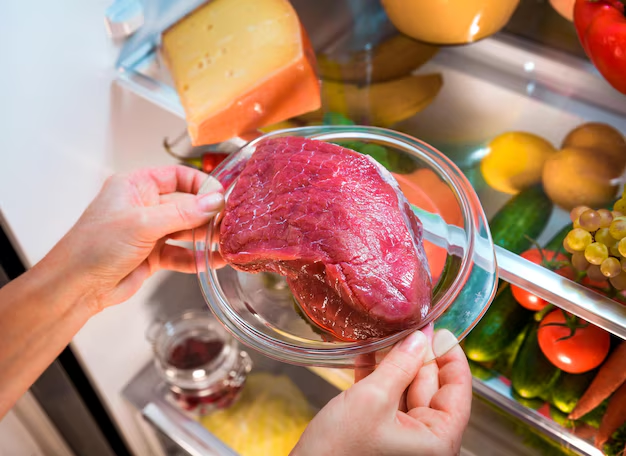Preserving Perfection: How Long Can You Keep Prime Rib in the Refrigerator?
Prime rib is a delicacy that many people savor during special occasions. It’s a culinary centerpiece boasting rich flavors and tenderness when cooked to perfection. However, after the feast is over, you might find yourself with leftovers. The question arises: How long can prime rib be stored in the refrigerator before it loses its quality or becomes unsafe to eat? This guide will explore everything you need to know about storing prime rib, ensuring it remains safe and delicious for as long as possible.
Understanding Prime Rib
What is Prime Rib?
Prime rib, also known as a standing rib roast, is a cut of beef from the primal rib section, known for its rich marbling and exceptional tenderness. This cut is often reserved for special meals and is typically prepared roasted, seasoned with herbs and spices.
The Importance of Proper Storage
Proper storage of prime rib is critical not only to maintain its flavor and texture but also to prevent foodborne illnesses. Beef, like other meats, can harbor harmful bacteria if not stored correctly.
Storing Prime Rib in the Refrigerator
How Long Does Prime Rib Last in the Refrigerator?
Prime rib typically stays fresh in the refrigerator for about 3 to 5 days if stored correctly. The timeframe can vary slightly depending on factors like how the meat was handled, cooked, and stored immediately after serving.
Tips for Maximizing Freshness
Cool Promptly: After serving, let the prime rib cool slightly, but do not leave it out for more than two hours at room temperature.
Proper Wrapping: Use airtight packaging or aluminum foil to tightly wrap the prime rib. This prevents exposure to air, which can lead to spoilage.
Refrigeration Temperature: Ensure your refrigerator is set below 40°F (4°C) to keep the meat at a safe storage temperature.
📝 Quick Storage Tips:
- Wrap in foil or use airtight containers.
- Store within two hours of serving.
- Keep refrigeration temperature consistent.
Factors Affecting Shelf Life
Nature of the Cut
The quality of the prime rib cut, including its marbling and overall condition, can influence how well it keeps. Higher quality cuts tend to retain their flavor and texture better over time.
Cooking Method
The method of cooking (whether you choose roasting, smoking, or grilling) can also affect how long leftover prime rib can stay in the fridge. Smoked meats, for example, tend to have a longer shelf life because of the curing process.
Seasoning and Marinades
Seasonings and marinades not only enhance flavor but also act as preservative agents to some degree. Certain herbs and spices have natural antimicrobial properties that can slightly extend the shelf life.
Recognizing Spoilage
Visual and Sensory Checks
Knowing how to identify when your prime rib has gone bad is crucial for food safety. Here are some signs:
Odor: A sour, unpleasant smell often indicates spoilage.
Texture: Slimy texture or an off texture is usually a clear indicator that the meat has spoiled.
Color Change: While beef can naturally darken, an unusual color shift to gray or green signifies spoilage.
Health Risks of Consuming Spoiled Meat
Consuming spoiled prime rib can pose health risks, including food poisoning from bacteria like Salmonella or E. coli. It's essential to discard any meat you suspect is spoiled rather than risk illness.
Freezing Prime Rib for Longer Storage
Can You Freeze Prime Rib?
Yes, freezing is an effective way to extend the storage life of prime rib beyond refrigeration limits. Properly wrapped and stored frozen, prime rib can last for up to 6 to 12 months.
Steps for Freezing Prime Rib
Cool Completely: Ensure the prime rib is completely cooled before freezing.
Wrap Thoroughly: Use heavy-duty aluminum foil or freezer paper, and place the wrapped meat in a freezer-safe bag to prevent freezer burn.
Label and Date: Always label the package with the date before storing it in the freezer.
Defrosting Prime Rib
When ready to consume, thaw the prime rib in the refrigerator for 24 hours per 5 pounds of meat. Once thawed, the meat should be cooked within 3 to 5 days.
🧊 Freezing Insights:
- Wrap tightly to prevent freezer burn.
- Label with freezing date.
- Thaw in the fridge, not at room temperature.
Culinary Tips for Leftover Prime Rib
Delicious Ways to Use Leftovers
Utilizing leftovers can lead to exciting new meals without the waste. Here are a few ideas:
Sandwiches: Thinly slice and use in sandwiches with your choice of sauces and sides.
Stir-Fries: Add sliced prime rib to stir-fried vegetables for a quick meal.
Soups and Stews: Dice the meat and add to soups or stews to enhance flavor.
Reheating Best Practices
To avoid drying the meat:
Low and Slow: Reheat in the oven at a low temperature covered with foil, maintaining moisture.
Sauté or Steam: Use a pan with a bit of beef broth on the stove for a quick reheat without drying out.
Summary: Keeping Prime Rib Perfect
Here's a snapshot of essential tips for preserving your prime rib:
- 🍽️ Storage Timeframe: Refrigerate for 3-5 days, or freeze for up to 12 months.
- 🥡 Storage Method: Wrap tightly to prevent exposure to air, keep refrigeration consistent at below 40°F (4°C).
- 🚫 Spoilage Signs: Check for off smells, strange textures, and discoloration.
- 📆 Planning Leftovers: Transform leftovers into creative meals to minimize waste.
- 🧊 Freezing Strategy: For long-term storage, freeze promptly and label with dates.
Remember, proper storage not only protects your health but also ensures your meals remain flavorful and enjoyable. With these tips, your prime rib can be savored long after the initial feast is over, keeping those delectable flavors and textures intact.
